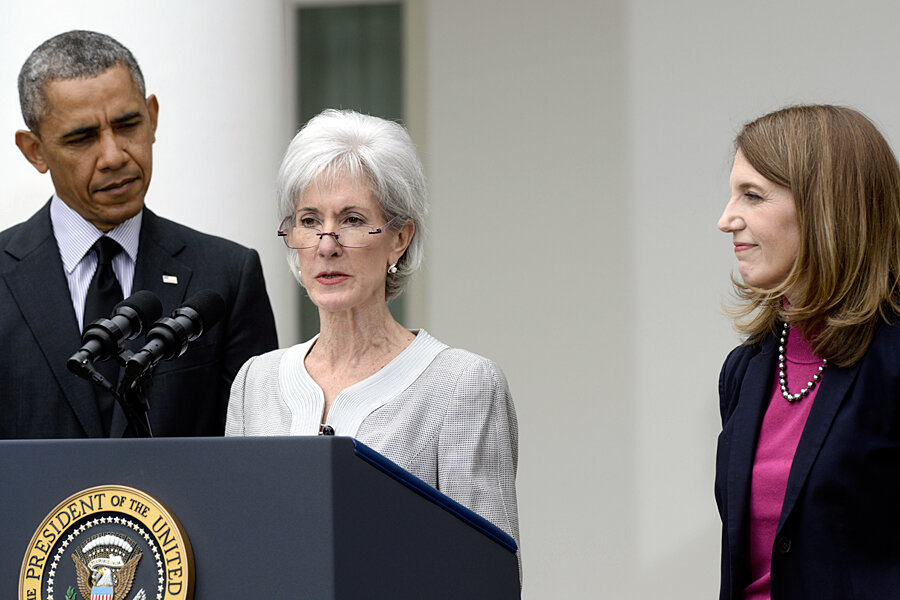Kathleen Sebelius departs: 10 flash points in her stewardship of Obamacare
| Washington
Once the Affordable Care Act was passed by a Democratic Congress and signed by President Obama, the job of being secretary of Health and Human Services (HHS) was to some degree bound to be a thankless one.
Kathleen Sebelius, who is now resigning from that job, was the one in position not to be thanked.
She had the task of implementing an incredibly complex law (flow chart, courtesy of Republicans) where virtually each attempted step was bound to draw criticism from conservative opponents, even as members of her own party pushed in varying directions (to be firm in this rule here, to delay that unpopular feature there).
Making things worse, critics say, were the former Kansas governor’s own missteps and failures of oversight – notably regarding the Obamacare enrollment website HealthCare.gov.
She resigns on a high note, with enrollment exceeding expectations that had been scaled back amid the website woes. But the question of success or failure for the law remains unsettled. Mr. Obama has named Sylvia Mathews Burwell, his budget director, to follow Ms. Sebelius and oversee the law's next stages.
Some Sebelius critics have empathy for the role she’s filled.
“I know you have one of the most difficult jobs in Washington,” Sen. Orrin Hatch (R) of Utah told Sebelius at a hearing Thursday, hours before news of her resignation emerged. “I appreciate you being here.”
Here, in chronological form, are some of the flash points during Sebelius’s tenure at HHS, which explain why she's been a magnet for controversy:
March 2010: Congress passes the Patient Protection and Affordable Care Act (typically referred to as the ACA), with no Republican support. The law is designed to get more Americans covered by health insurance through an expansion of Medicaid and an “individual mandate” that people have insurance starting in 2014 or pay a tax penalty.
January 2012: HHS takes fire from the Catholic Church and others concerned with religious liberty for issuing an ACA-related rule requiring health insurance plans to cover contraceptive services. Entities such as colleges or hospitals tied to the Catholic faith got no exemption from the rule, but the administration offered a compromise in which the cost of contraceptives would be born by insurance companies rather than church-linked institutions.
June 2012: From the get-go, the law faces legal challenges as well as Republican opposition. In a major ruling on some of the main constitutional questions, the US Supreme Court upholds most of the law. But the court says the expansion of Medicaid must be optional for states. Many Republican-led states end up opting out.
December 2012: Despite being given extra time to decide, most states opt not to develop their own enrollment websites. This leaves the task of setting up many insurance marketplaces and the Web portal for enrollment to HHS.
March 2013: Henry Chao, an HHS official on the front lines of preparing the website for individuals to enroll, hints at the challenges when he says at a conference that the agency’s goal for the website is simply to “make sure it's not a third-world experience."
April 2013: Sebelius gives her own comments on the challenges she faces, saying: “The politics has been relentless.... There was some hope that once the Supreme Court ruled ... and then once an election occurred there would be a sense that, 'This is the law of the land, let's get on board, let's make this work.' And yet we find ourselves still having state-by-state political battles."
July 2013: The administration delays the law’s “employer mandate,” which calls on businesses with 50 or more full-time workers to offer health coverage or pay a tax penalty. The fines, intended to come alongside the individual mandate, are pushed to 2015.
October 2013: The HealthCare.gov website crashes on launch, performs poorly during the opening weeks of enrollment, and becomes a target for congressional hearings. Lawmakers hear that the website wasn’t well tested and debugged prior to launch and that costs paid to private contractors have soared beyond initial estimates. Sebelius makes herself the target for blame, saying Obama didn’t know of website challenges prior to the launch. This month is a low point for Sebelius, putting her at the center of a "Saturday Night Live" website sendup.
March 2014: Reversing course after implying that a March 31 enrollment deadline would be final, Sebelius says the deadline will be extended for people who started to sign up by the end of March but failed to finish. Critics call it just the latest example of delay and selective enforcement.
April 2014: Sebelius announces early on April 10 that the post-March grace period has allowed enrollment on the marketplaces to rise to 7.5 million people. By that evening, word of her resignation has emerged.







